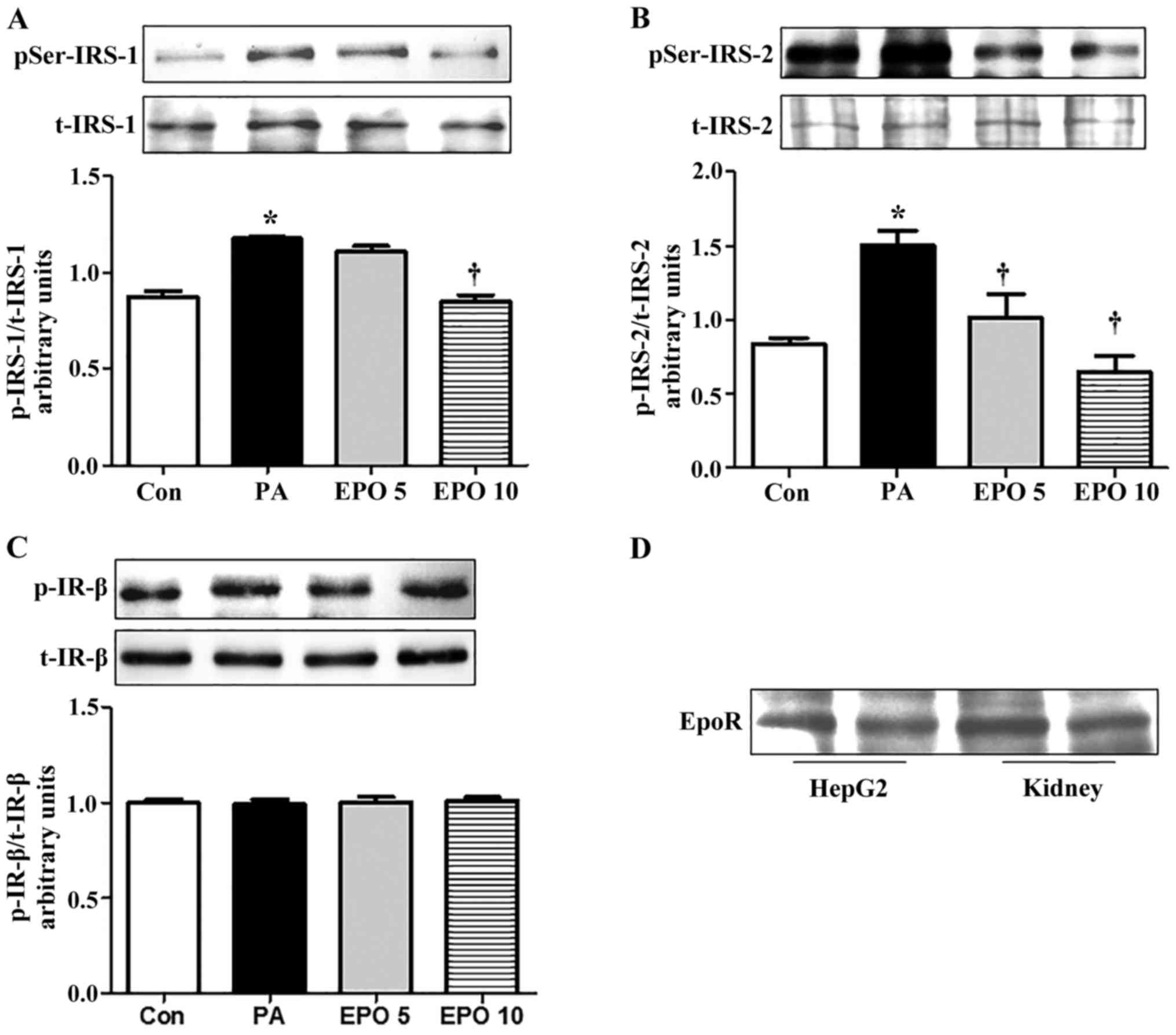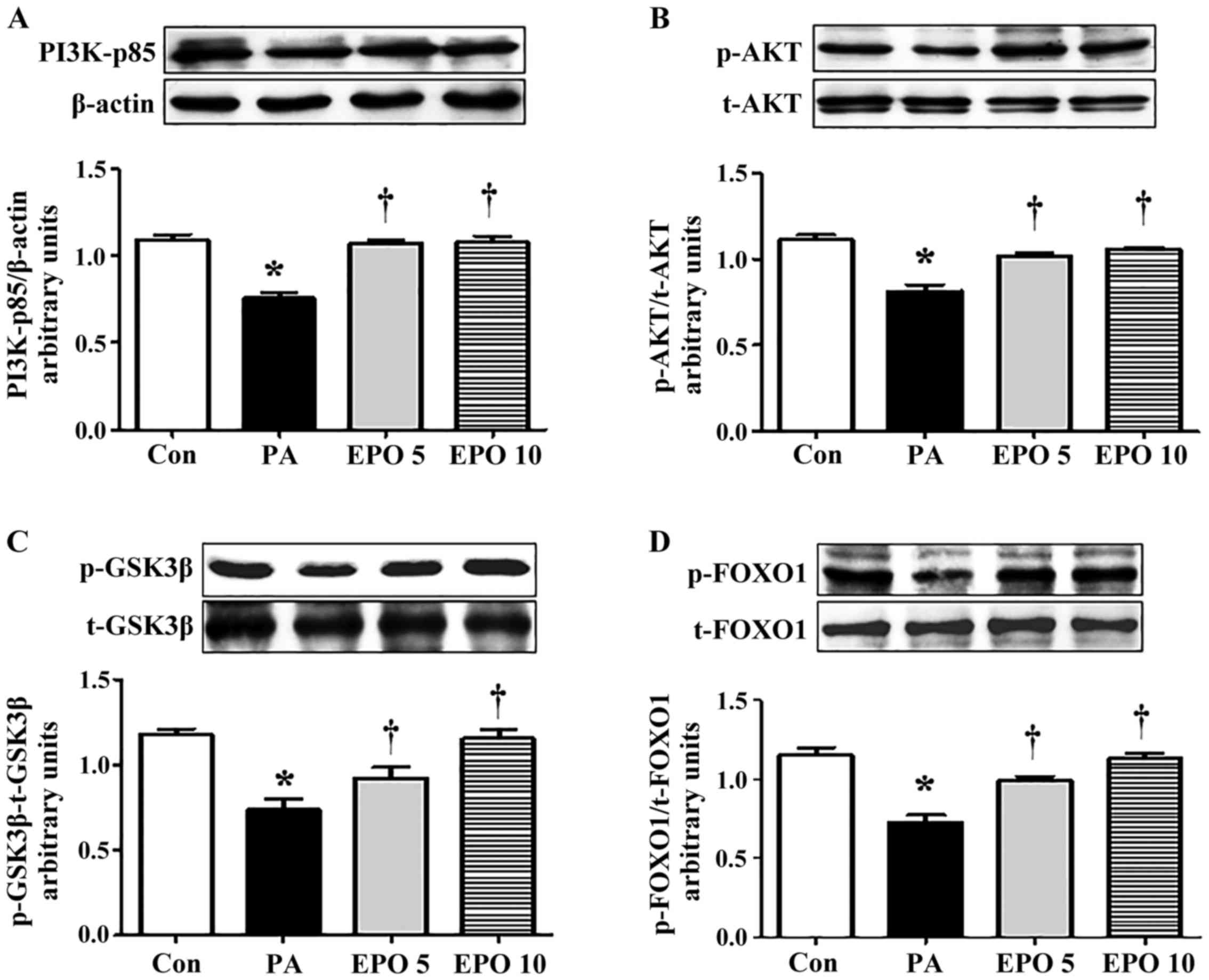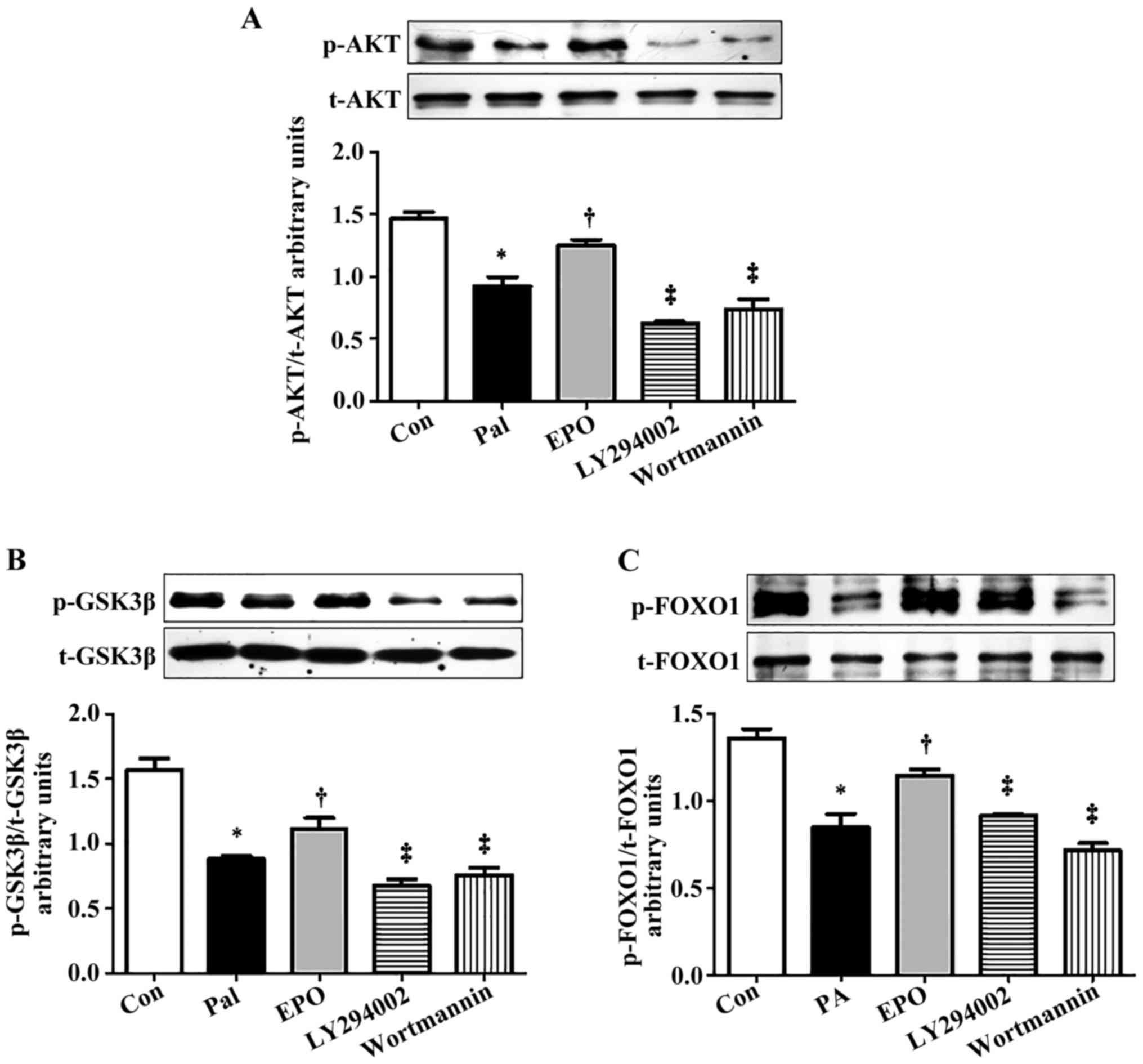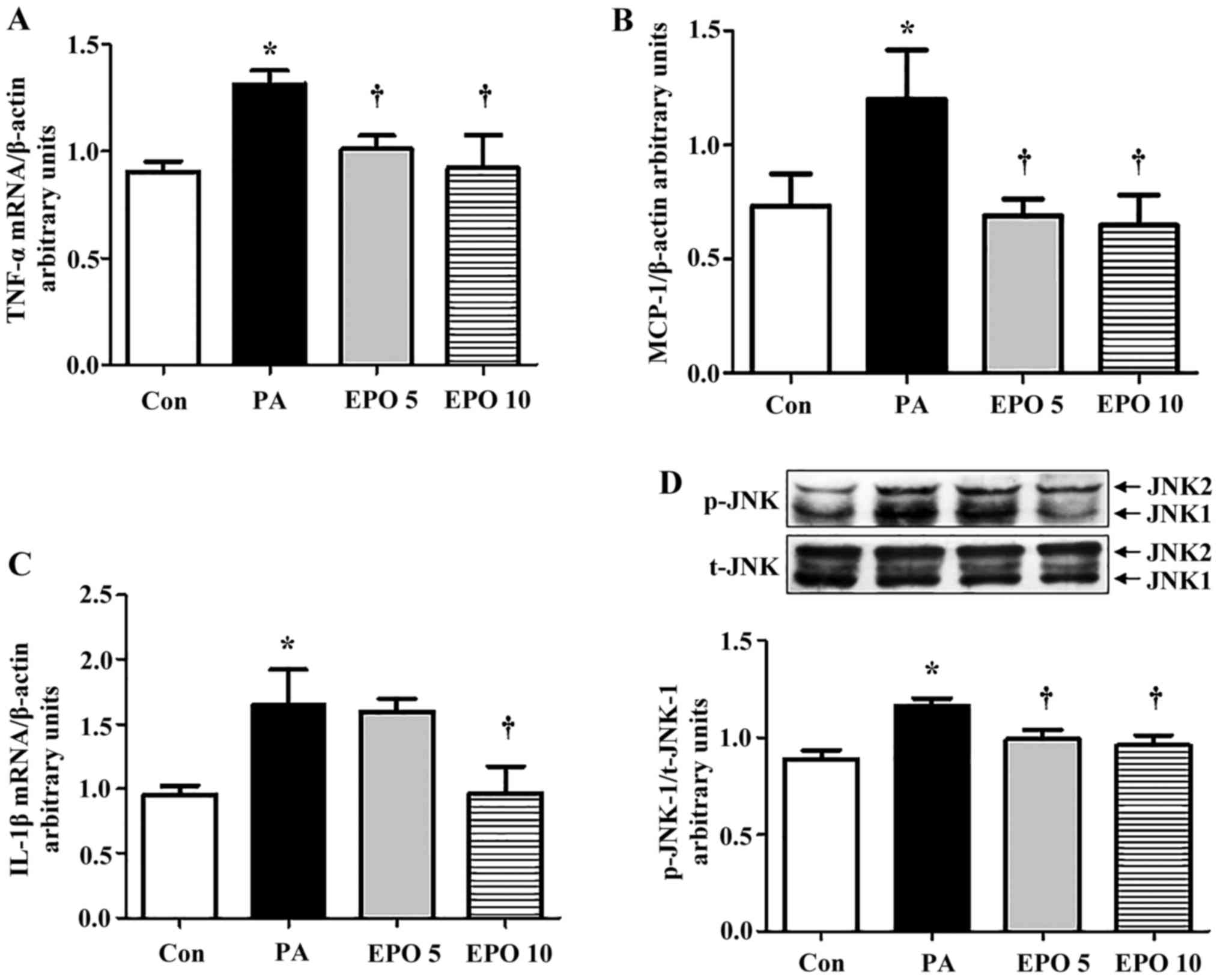Erythropoietin ameliorates PA-induced insulin resistance through the IRS/AKT/FOXO1 and GSK-3β signaling pathway, and inhibits the inflammatory response in HepG2 cells
- Authors:
- Published online on: June 20, 2017 https://doi.org/10.3892/mmr.2017.6810
- Pages: 2295-2301
Abstract
Introduction
Hepatic insulin resistance is a critical component in the development of type 2 diabetes. Excess adiposity and a high-fat diet is associated with lipid accumulation in the liver, resulting in increased circulating free fatty acids (FFAs), and the subsequent production of pro-inflammatory cytokines, including tumor necrosis factor-α (TNF-α), interleukin-1β (IL-1β) and monocyte chemoattractant protein-1 (MCP-1), which are important in the development of hepatic insulin resistance (1,2).
The c-Jun amino-terminal kinases (JNKs), particularly JNK1, have been considered to be a critical molecular link between hepatic insulin resistance and inflammation, and a potential target for therapeutics (3). JNK1 can be activated by inflammatory cytokines and FFA, resulting in the phosphorylation of insulin receptor substrates (IRSs) at serine and threonine residues in the liver. This inhibits downstream insulin signaling, including the inactivation of phosphatidylinositol 3-kinase (PI3K) and protein kinase B (PKB/AKT). In the liver, AKT phosphorylates a number of substrates, including forkhead box O1 (FOXO1), controlling the transcription of genes encoding gluconeogenic enzymes, and glycogen synthase kinase (GSK)-3α/β, regulating glycogen synthesis (4,5).
Erythropoietin (EPO), a kidney cytokine regulating hematopoiesis, has been widely used for the treatment of anemia in patients with chronic kidney disease (6). EPO has also been shown to exhibit anti-inflammatory effects in previous studies. It was demonstrated that EPO attenuated ischemia-induced inflammation by reducing the levels of TNF-α, IL-6 and MCP-1 in the ischemic brain and heart in an experimental model of autoimmune myocarditis (7,8). EPO treatment has also been shown to decrease serum levels of TNF-α and IL-6, and reduce insulin resistance in non-diabetic patients on maintenance hemodialysis (9). Our previous study in mice suggested that EPO treatment improved glucose intolerance by inhibiting inflammation in the liver (10). This led to the hypothesis that hepatic insulin signaling may be regulated by EPO treatment in vitro through suppression of the inflammatory response; however, the mechanism remains to be fully elucidated.
The aim of the present study was to evaluate the anti-inflammatory activity of EPO involved in the modulation of insulin sensitivity in PA-induced HepG2 cells, which may assist in clarifying the pharmacological function of EPO in hepatic insulin resistance. The data revealed that EPO inhibited the gene expression of TNF-α, IL-1β and MCP-1 and the phosphorylation of JNK1, which may be closely associated with the improvement of hepatic insulin signaling and glucose metabolism by EPO.
Materials and methods
Reagents
Palmitic acid (PA) was purchased from Sigma-Aldrich; Merck KGaA (Darmstadt, Germany). Recombinant human EPO was from Shenyang Sunshine Pharmaceutical Company (Shenyang, China). TRIzol and primers were from Invitrogen; Thermo Fisher Scientific, Inc. (Waltham, MA, USA). The reverse transcription kit was purchased from Takara Biotechnology Co., Ltd. (Dalian, China). Antibodies against phosphorylated (p)-insulin receptor (IR)-β (Tyr1361), p85 subunit of PI3K (PI3K-p85), p-AKT (Ser473), AKT, FOXO1, p-FOXO1 (Ser256), GSK-3β, p-GSK-3β (Ser9), p-IRS-1 (Ser307), IRS-1, IRS-2, p-JNK (Thr183/Tyr185), JNK, and the PI3K inhibitors, LY294002 and wortmannin, were from Cell Signaling Technology, Inc. (Danvers, MA, USA). Anti-p-IRS-2 (Ser731) was purchased from AnaSpec (Fremont, CA, USA). Anti-EPO receptor (EPOR), anti-phosphoenolpyruvate carboxykinase (PEPCK), total (t-)IR-β, and anti-β-actin antibodies were from Santa Cruz Biotechnology, Inc. (Dallas, TX, USA). The PI3K inhibitors were reconstituted fresh in DMSO prior to use and were protected from light exposure during the experiments.
Cell culture
The HepG2 cells were obtained from the Chinese Academy of Sciences, cultured in Dulbecco's modified Eagle's medium with 10% fetal bovine serum (Gibco; Thermo Fisher Scientific, Inc.) and 1% penicillin-streptomycin (Gibco; Thermo Fisher Scientific, Inc.). Insulin resistance was induced by the addition of 0.25 mmol/l PA to the medium for 24 h (11). The solution of PA was prepared as previously described (12). To examine the effect of EPO, the cells were incubated in a 37°C, 5% CO2 incubator for 12 h in serum-free medium and treated with 5 or 10 U/ml EPO for 24 h. The PI3K inhibitors, wortmannin or LY294002, were added 1 h prior to EPO exposure and were present throughout EPO administration. The cells were washed twice with PBS following incubation with 100 nmol/l insulin (Sigma-Aldrich; Merck KGaA) for 15 min. The protein and mRNA were then harvested immediately.
Analysis of glycogen content
The glycogen levels were measured in cells incubated at 37°C for 3 h in the presence of 1 nmol/l insulin, using a glycogen assay kit (BioVision, Inc., Milpitas, CA, USA) as previously described (11). Briefly, 106 HepG2 cells were homogenized with 200 µl dH2O on ice, and the homogenates were boiled for 5 min to inactivate enzymes, followed by centrifugation of the boiled samples at 18,000 × g for 5 min at room temperature to remove insoluble material. The supernatants were ready for use in assays following hydrolyzing by adding hydrolyzing enzyme mix to standards and samples, mixing and incubating for 30 min at room temperature. The optical density values of samples were measured at 570 nm.
Western blot analysis
The HepG2 cells were washed twice with cold PBS and lysed in ice-cold cell lysis buffer supplemented with protease inhibitor cocktail (Roche Diagnostics, Basel, Switzerland), and the protein concentration was determined using the bicinchoninic acid method. The protein lysates were dissolved in loading buffer and boiled for 5 min. The 30-µg samples of proteins were separated by SDS-PAGE on a 10% gel, transferred onto a PVDF membrane and blocked with 7.5% non-fat milk. The membrane was then incubated with appropriate primary antibodies overnight at 4°C: Rabbit anti-phosphorylated (p)-IR-β (Tyr1361; cat. no. 3023; 1:2,000); rabbit anti-PI3K-p85 (cat. no. 4292; 1:2,000); rabbit anti-p-AKT (Ser473; cat. no. 9271; 1:2,000); rabbit anti-tAKT (cat. no. 9272; 1:2,000); rabbit anti-t-FOXO1 (cat. no. 2880; 1:1,000); rabbit anti-p-FOXO1 (Ser256; cat. no. 9461; 1:1,000); rabbit anti-GSK-3β (cat. no. 9315; 1:1,000); rabbit anti-p-GSK-3β (Ser9; cat. no. 9336; 1:1,000); rabbit anti-p-IRS-1 (Ser307; cat. no. 2381; 1:1,000); rabbit anti-t-IRS-1 (cat. no. 2382; 1:1,000); rabbit anti-t-IRS-2 (cat. no. 3089; 1:1,000); rabbit anti-p-JNK (Thr183/Tyr185; cat. no. 9251; 1:1,000); rabbit anti-t-JNK (cat. no. 9252; 1:1,000); rabbit anti-p-IRS-2 (Ser731; cat. no. AS-28122; 1:1,000); rabbit anti-EPOR (cat. no. sc-695; 1:4,000); rabbit anti-PEPCK (cat. no. sc-32879; 1:5,000); goat anti-t-IR-β (cat. no. sc-31367; 1:2,000); and mouse anti-β-actin (cat. no. sc-47778; 1:4,000). Subsequently, the membrane was incubated with appropriate secondary antibodies (all Santa Cruz Biotechnology, Inc.) for 1 h at room temperature: Bovine anti-goat immunoglobulin (Ig)G-horseradish peroxidase (HRP) (cat. no. sc-2350; 1:8,000); bovine anti-mouse IgG-HRP (cat. no. sc-2371; 1:10,000); and bovine anti-rabbit IgG-HRP (cat. no. sc-2370; 1:8,000). The proteins were visualized using enhanced chemiluminescence (EMD Millipore, Billerica, MA, USA) and quantified using densitometry (Quantity One software; version 462; Bio-Rad Laboratories, Inc., Hercules, CA, USA).
Reverse transcription-quantitative polymerase chain reaction (RT-qPCR) analysis
Total RNA was extracted using the standard TRIzol RNA isolation method (Invitrogen; Thermo Fisher Scientific, Inc.). cDNA was synthesized from 2 µg total RNA using a PrimeScript RT reagent kit (Takara Bio, Inc., Otsu, Japan). cDNA was stored at −80°C until qPCR analysis, which was performed in an Applied Biosystems 7500 Real-Time PCR system, using SYBR Premix Ex Taq (Takara Bio, Inc.). The reaction mixture (20 µl) consisted of 2 µl cDNA, 10 µl 2X SYBR Premix Ex Taq™, 0.4 µl each of forward and reverse primers, and 0.4 µl 50X ROX Reference dye. The PCR conditions were as follows: 95°C for 30 sec, followed by 40 cycles at 95°C for 5 sec and 60°C for 34 sec. The specific primers used are presented in Table I. The results were normalized against the gene expression of β-actin using the 2−ΔΔCq method (13).
Table I.Specific primers pairs used in reverse transcription-quantitative polymerase chain reaction analysis. |
Statistical analysis
Data were analyzed using SPSS software (version 13.0; SPSS, Inc., Chicago, IL, USA). Data are expressed as the mean ± standard error of the mean. Statistical significance was determined using one-way analysis of variance followed by Dunnett's or the LSD post-hoc test. P<0.05 was considered to indicate a statistically significant difference.
Results
EPO ameliorates insulin signaling through the phosphorylation of IRS-1 and IRS-2 serine residues, but not IR, in PA-induced HepG2 cells
The serine phosphorylation of IRS inhibits insulin signaling through the inactivation of tyrosine phosphorylation of IRS, and results in insulin resistance (14,15). The results of the present study suggested that the protein expression of insulin-stimulated p-IRS-2 (Ser731) was reduced by treatment with 5 and 10 U/ml EPO in the PA-induced HepG2 cells, whereas the protein expression of p-IRS-1 (Ser307) was inhibited only in the 10 U/ml EPO treatment group (Fig. 1A and B). However, the protein levels of t-IRS-2, IRS-1, p-IR-β (Tyr1361) and t-IR-β were not altered by EPO treatment (Fig. 1C). EPO mediates biological effects and downstream signaling primarily through binding to its receptor, EPOR. Therefore, the protein expression of EPOR (Fig. 1D) was detected in the HepG2 cells. The result showed that EPOR was expressed in the HepG2 cells, suggesting an EPO-mediated regulatory effect on glucose metabolism.
Inhibitors of PI3K inhibit the EPO-mediated beneficial effects on the hepatic insulin signaling pathway
The PI3K/AKT signaling pathway, activated by the tyrosine phosphorylation of IRS, is primarily responsible for the effect of insulin on gluconeogenesis and glycogen synthesis in hepatocytes. To understand the mechanisms underlying the effect of EPO, the present study examined the levels of PI3K-p85, t-AKT, p-AKT (Ser473), t-FOXO1, p-FOXO1 (Ser256), t-GSK-3β and p-GSK-3β (Ser9) in the PA-induced HepG2 cells. The results showed that EPO treatment led to increased protein expression levels of PI3K-p85, p-AKT (Ser473), p-FOXO1 (Ser256) and p-GSK-3β (Ser9), whereas no significant differences were found in the levels of t-AKT, t-FOXO1 or t-GSK-3β (Fig. 2A-D). Exposure of the cells to the specific PI3K signaling pathway inhibitors, wortmannin (0.5 µmol/l) or LY294002 (10 µmol/l), for 1 h markedly inhibited the EPO-mediated increase in the protein levels of p-AKT (Ser473), p-GSK-3β (Ser9) and p-FOXO1 (Ser256) (Fig. 3A-C).
EPO improves glucose metabolism in insulin-resistant HepG2 cells
The results of the present study revealed that the insulin-stimulated glycogen content in the insulin-resistant HepG2 cells was significantly decreased, whereas the protein expression of phosphoenolpyruvate carboxykinase (PEPCK), a rate-limiting enzyme in the process of gluconeogenesis, was significantly increased. Following treatment with 5 or 10 U/ml of EPO, the glycogen level (Fig. 4A) was upregulated and the protein expression of PEPCK was downregulated (Fig. 4B).
Effects of EPO on PA-induced inflammatory signaling
The gene expression levels of TNF-α and MCP-1 were increased in the PA-induced HepG2 cells, and were significantly decreased following treatment with 5 or 10 U/ml EPO (Fig. 5A and B), whereas the IL-1β gene showed a significant decline only following treatment with 10 U/ml EPO (Fig. 5C). Furthermore, the increased activity of JNK1 (the ratio of p-JNK1/JNK1) by PA was markedly suppressed by 5 and 10 U/ml EPO treatment, but the activity of JNK2 was not (Fig. 5D), as detected using western blot analysis.
Discussion
Although initially identified in the hematopoietic system, EPOR is expressed in various non-hematopoietic organs, including the brain, heart, kidney, retina and vascular endothelium. Ubiquitous EPOR has been associated with diverse regulatory effects for EPO, including neurotrophic, cardioprotective and renoprotective effects, and modulation of the immunological, inflammatory response (16). In our previous study, it was found that EPOR mRNA was expressed in the livers of mice (10). In the present study, the expression of EPOR was detected in HepG2 cells, suggesting that EPO may mediate its biological function on hepatic insulin resistance in HepG2 cells. The results indicated that EPO treatment ameliorated hepatic glucose metabolism and the insulin signaling pathway via the IRS/AKT/FOXO1 and GSK-3β pathway, and through inhibition of the inflammatory response.
Previous studies have suggested that EPO improves several metabolic parameters when administered to patients with chronic kidney disease (17–19). The role and mechanism of EPO in regulating insulin resistance has been reported previously. Mice lacking EPOR in non-hematopoietic tissue became insulin resistant with abnormal glucose metabolism (20). Similarly, mice overexpressing the EPO gene in muscle tissue showed a significant improvement in the levels of blood glucose through increases in oxidative metabolism, fatty acid oxidation and key metabolic genes in muscle (21). Evidence in insulin-resistant 3T3L1 adipocytes suggested that EPO treatment improves insulin resistance via the EPOR-associated phosphorylation of signal transducer and activator of transcription 5 and AKT, and inflammation (22). Consistent with this data, a previous study involving EPOR-knockout mice and adipocyte models demonstrated that the action of EPO in increasing metabolic activity and browning of white adipocytes was mediated by peroxisome proliferators-activated receptor α and sirtuin 1 (23). These data suggest that EPO contributes to insulin resistance in the fat and muscle.
Previous studies have not examined the role and mechanism of EPO in hepatic insulin resistance, in which the insulin signaling cascade is different from that in fat and muscle tissues. Our previous study in high-fat diet fed mice showed that EPO regulated the phosphorylation of AKT and improved glucose intolerance (10). In the present study, it was found that EPO treatment significantly reduced the protein expression of PEPCK and enhanced glycogen levels in PA-induced HepG2 cells. The present study also observed for the first time, to the best of our knowledge, that the serine phosphorylation of IRS-1 and IRS-2 were inhibited by EPO treatment in PA-exposed HepG2 cells, whereas the insulin-stimulated phosphorylation of IR, an upstream molecule of IRS, was not altered by EPO treatment. In addition, the levels of PI3K-p85, p-AKT, p-FOXO1 and p-GSK-3β, downstream molecules of IRS, were increased by EPO treatment. Through the inhibition of PI3K, it was demonstrated that PI3K inhibitors, LY294002 and wortmannin, significantly suppressed the phosphorylation of AKT, FOXO1 and GSK-3β. Taken together, these results are consistent with the hypothesis that EPO treatment improves hepatic insulin signaling in PA-induced HepG2 cells via the IRS/PI3K/AKT/FOXO1 and GSK-3β pathway.
The fatty acid-associated activation of JNK1 and production of inflammatory cytokines are important in hepatic insulin resistance (11,24,25). The activation of JNK1 directly interferes with insulin signaling in hepatocytes. This interference is based on the direct phosphorylation of IRS-1 and IRS-2 at inhibitory sites, which inhibits recruitment to activated IR. The JNK-mediated phosphorylation of IRS disrupts downstream events, including activation of the PI3K/AKT cascade (26–28). Therefore, further investigations are required to determine whether improvements in the activities of IRS-1 and IRS-2 by EPO are associated with the suppressive role of EPO on the inflammatory pathway in PA-induced HepG2 cells. In the present study, it was observed that the gene expression levels of TNF-α, IL-1β and MCP-1 were significantly decreased by EPO treatment in the PA-exposed HepG2 cells. In agreement with alterations in pro-inflammatory markers, the activity of JNK1 was suppressed by EPO treatment. These findings indicated that the improvement of hepatic insulin resistance by EPO may be, at least in part, mediated by inhibiting inflammation-associated signaling.
In conclusion, the present study demonstrated that EPO treatment significantly improved glucose metabolism in PA-induced HepG2 cells. Furthermore, the data revealed a key mechanism of EPO in regulating hepatic insulin resistance, which ameliorated the phosphorylation of IRS-1 and IRS-2, and the downstream activation of AKT/FOXO1 and GSK-3β. These effects may be associated with the inhibitory role of EPO on the inflammatory response. These findings offer a novel mechanistic understanding of the beneficial effects of EPO on hepatic insulin resistance, to assist in the treatment of insulin resistance and diabetes in the future.
Acknowledgements
This study was supported by the National Natural Science Foundation of China Grant Award (grant no. 81200595/81400807), the Project of Six High-peak Talents of Jiangsu Province (grant no. WSN-101), the Natural Science Foundation of Jiangsu Province (grant no. KA037), the Research Project of Jiangsu Province 333 Engineering (grant no. BRA2016232), and the Research Project of Jiangsu Provincial Commission of Health and Family Planning (grant nos. H201667 and F201549). Some of the data were presented as an abstract at the American Diabetes Association 73th Scientific Sessions (ADA) in 2013 (number 3664).
References
|
Weickert MO and Pfeiffer AF: Signalling mechanisms linking hepatic glucose and lipid metabolism. Diabetologia. 49:1732–1741. 2006. View Article : Google Scholar : PubMed/NCBI | |
|
Samuel VT and Shulman GI: Mechanisms for insulin resistance: Common threads and missing links. Cell. 148:852–871. 2012. View Article : Google Scholar : PubMed/NCBI | |
|
Solinas G, Naugler W, Galimi F, Lee MS and Karin M: Saturated fatty acids inhibit induction of insulin gene transcription by JNK-mediated phosphorylation of insulin-receptor substrates. Proc Natl Acad Sci USA. 103:16454–16459. 2006. View Article : Google Scholar : PubMed/NCBI | |
|
Hirosumi J, Tuncman G, Chang L, Görgün CZ, Uysal KT, Maeda K, Karin M and Hotamisligil GS: A central role for JNK in obesity and insulin resistance. Nature. 420:333–336. 2002. View Article : Google Scholar : PubMed/NCBI | |
|
Galbo T, Olsen GS, Quistorff B and Nishimura E: Free fatty acid-induced PP2A hyperactivity selectively impairs hepatic insulin action on glucose metabolism. PLoS One. 6:e274242011. View Article : Google Scholar : PubMed/NCBI | |
|
Bahlmann FH and Fliser D: Erythropoietin and renoprotection. Curr Opin Nephrol Hypertens. 18:15–20. 2009. View Article : Google Scholar : PubMed/NCBI | |
|
Mitsuma W, Ito M, Kodama M, Fuse K, Okamura K, Minagawa S, Kato K, Hanawa H, Toba K, Nakazawa M and Aizawa Y: Cardioprotective effects of recombinant human erythropoietin in rats with experimental autoimmune myocarditis. Biochem Biophys Res Commun. 344:987–994. 2006. View Article : Google Scholar : PubMed/NCBI | |
|
Villa P, Bigini P, Mennini T, Agnello D, Laragione T, Cagnotto A, Viviani B, Marinovich M, Cerami A, Coleman TR, et al: Erythropoietin selectively attenuates cytokine production and inflammation in cerebral ischemia by targeting neuronal apoptosis. J Exp Med. 198:971–975. 2003. View Article : Google Scholar : PubMed/NCBI | |
|
Rasic-Milutinovic Z, Perunicic-Pekovic G, Cavala A, Gluvic Z, Bokan L and Stankovic S: The effect of recombinant human erythropoietin treatment on insulin resistance and inflammatory markers in non-diabetic patients on maintenance hemodialysis. Hippokratia. 12:157–161. 2008.PubMed/NCBI | |
|
Meng R, Zhu D, Bi Y, Yang D and Wang Y: Erythropoietin inhibits gluconeogenesis and inflammation in the liver and improves glucose intolerance in high-fat diet-fed mice. PLoS One. 8:e535572013. View Article : Google Scholar : PubMed/NCBI | |
|
Gao D, Nong S, Huang X, Lu Y, Zhao H, Lin Y, Man Y, Wang S, Yang J and Li J: The effects of palmitate on hepatic insulin resistance are mediated by NADPH Oxidase 3-derived reactive oxygen species through JNK and p38MAPK pathways. J Biol Chem. 285:29965–29973. 2010. View Article : Google Scholar : PubMed/NCBI | |
|
Copps KD and White MF: Regulation of insulin sensitivity by serine/threonine phosphorylation of insulin receptor substrate proteins IRS1 and IRS2. Diabetologia. 55:2565–2582. 2012. View Article : Google Scholar : PubMed/NCBI | |
|
Livak KJ and Schmittgen TD: Analysis of relative gene expression data using real time quantitative PCR and the 2(−Delta Delta C(T) Method. Methods. 25:402–408. 2001. View Article : Google Scholar : PubMed/NCBI | |
|
Taniguchi CM, Ueki K and Kahn R: Complementary roles of IRS-1 and IRS-2 in the hepatic regulation of metabolism. J Clin Invest. 115:718–727. 2005. View Article : Google Scholar : PubMed/NCBI | |
|
Piro S, Maniscalchi ET, Monello A, Pandini G, Mascali LG, Rabuazzo AM and Purrello F: Palmitate affects insulin receptor phosphorylation and intracellular insulin signal in a pancreatic alpha-cell line. Endocrinology. 151:4197–4206. 2010. View Article : Google Scholar : PubMed/NCBI | |
|
Arcasoy MO: The non-haematopoietic biological effects of erythropoietin. Br J Haemato. 141:14–31. 2008. View Article : Google Scholar | |
|
Allegra V, Mengozzi G, Martimbianco L and Vasile A: Early and late effects of erythropoietin on glucose metabolism in maintenance hemodialysis patients. Am J Nephrol. 16:304–308. 1996. View Article : Google Scholar : PubMed/NCBI | |
|
Khedr E, El-Sharkawy M, Abdulwahab S, Eldin EN, Ali M, Youssif A and Ahmed B: Effect of recombinant human erythropoietin on insulin resistance in hemodialysis patients. Hemodial Int. 13:340–346. 2009. View Article : Google Scholar : PubMed/NCBI | |
|
Tuzcu A, Bahceci M, Yilmaz E, Bahceci S and Tuzcu S: The comparison of insulin sensitivity in non-diabetic hemodialysis patients treated with and without recombinant human erythropoietin. Horm Metab Res. 36:716–720. 2004. View Article : Google Scholar : PubMed/NCBI | |
|
Teng R, Gavrilova O, Suzuki N, Chanturiya T, Schimel D, Hugendubler L, Mammen S, Yver DR, Cushman SW, Mueller E, et al: Disrupted erythropoietin signalling promotes obesity and alters hypothalamus proopiomelanocortin production. Nat Commun. 2:5202011. View Article : Google Scholar : PubMed/NCBI | |
|
Hojman P, Brolin C, Gissel H, Brandt C, Zerahn B, Pedersen BK and Gehl J: Erythropoietin over-expression protects against diet-induced obesity in mice through increased fat oxidation in muscles. PLoS One. 4:e58942009. View Article : Google Scholar : PubMed/NCBI | |
|
Pan Y, Shu JL, Gu HF, Zhou DC, Liu XL, Qiao QY, Fu SK, Gao FH and Jin HM: Erythropoietin improves insulin resistance via the regulation of its receptor-mediated signaling pathway in 3T3L1 adipocytes. Mol Cell Endocrinol. 367:116–123. 2013. View Article : Google Scholar : PubMed/NCBI | |
|
Wang L, Teng R, Di L, Rogers H, Wu H, Kopp JB and Noguchi CT: PPARα and Sirt1 mediate erythropoietin action in increasing metabolic activity and browning of white adipocytes to protect against obesity and metabolic disorders. Diabetes. 62:4122–4131. 2013. View Article : Google Scholar : PubMed/NCBI | |
|
Haus JM, Solomon TP, Marchetti CM, Edmison JM, González F and Kirwan JP: Free fatty acid-induced hepatic insulin resistance is attenuated following lifestyle intervention in obese individuals with impaired glucose tolerance. J Clin Endocrinol Metab. 95:323–327. 2010. View Article : Google Scholar : PubMed/NCBI | |
|
Hotamisligil GS: Inflammation and metabolic disorders. Nature. 444:860–867. 2006. View Article : Google Scholar : PubMed/NCBI | |
|
Solinas G and Karin M: JNK1 and IKKbeta: Molecular links between obesity and metabolic dysfunction. FASEB J. 24:2596–2611. 2010. View Article : Google Scholar : PubMed/NCBI | |
|
Tanti JF and Jager J: Cellular mechanisms of insulin resistance: Role of stress-regulated serine kinases and insulin receptor substrates (IRS) serine phosphorylation. Curr Opin Pharmacol. 9:753–762. 2009. View Article : Google Scholar : PubMed/NCBI | |
|
Taniguchi CM, Kondo T, Sajan M, Luo J, Bronson R, Asano T, Farese R, Cantley LC and Kahn CR: Divergent regulation of hepatic glucose and lipid metabolism by phosphoinositide 3-kinase via Akt and PKClambda/zeta. Cell Metab. 3:343–353. 2006. View Article : Google Scholar : PubMed/NCBI |














